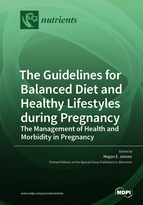The Guidelines for Balanced Diet and Healthy Lifestyles during Pregnancy: The Management of Health and Morbidity in Pregnancy
A special issue of Nutrients (ISSN 2072-6643). This special issue belongs to the section "Nutrition and Public Health".
Deadline for manuscript submissions: closed (31 August 2020) | Viewed by 104368
Special Issue Editor
Interests: nutrition; asthma; pediatrics; vitamin D; dietitian; clinical trials; obesity; body composition; pregnancy; breastfeeding; respiratory
Special Issues, Collections and Topics in MDPI journals
Special Issue Information
Dear Colleagues,
Pregnancy is a critical time in determining maternal health and future offspring health. Diet and lifestyle practices in the preconception and gestational period play an important role in optimising the health of both mother and child and in determining the risk of certain morbidities during pregnancy, including diabetes and hypertension, as well as their management. This Special Issue will collate the most recent research on the guidelines for dietary intake (including individual nutrients, dietary patterns, diet quality and food restrictions/avoidance) and lifestyle recommendations (including sleep, physical activity and environmental exposures) during pregnancy and the role they play in determining maternal and fetal health outcomes during pregnancy. Original research, systematic reviews and meta-analyses are preferred; however, narrative reviews are also welcome. Manuscripts that investigate nutrition/lifestyle factors as exposures during pregnancy and their impact on health during pregnancy are preferred; however, articles which examine the guidelines for, and/or the role of, diet and healthy lifestyles in the preconception period will also be considered, where the outcome is measured during pregnancy. Articles which examine maternal/offspring outcomes in the neonatal period may also be considered where the diet/lifestyle exposure was measured during gestation.
Dr. Megan E. Jensen
Guest Editor
Manuscript Submission Information
Manuscripts should be submitted online at www.mdpi.com by registering and logging in to this website. Once you are registered, click here to go to the submission form. Manuscripts can be submitted until the deadline. All submissions that pass pre-check are peer-reviewed. Accepted papers will be published continuously in the journal (as soon as accepted) and will be listed together on the special issue website. Research articles, review articles as well as short communications are invited. For planned papers, a title and short abstract (about 100 words) can be sent to the Editorial Office for announcement on this website.
Submitted manuscripts should not have been published previously, nor be under consideration for publication elsewhere (except conference proceedings papers). All manuscripts are thoroughly refereed through a single-blind peer-review process. A guide for authors and other relevant information for submission of manuscripts is available on the Instructions for Authors page. Nutrients is an international peer-reviewed open access semimonthly journal published by MDPI.
Please visit the Instructions for Authors page before submitting a manuscript. The Article Processing Charge (APC) for publication in this open access journal is 2900 CHF (Swiss Francs). Submitted papers should be well formatted and use good English. Authors may use MDPI's English editing service prior to publication or during author revisions.
Keywords
- Diet
- Nutrients
- Energy intake
- Gestational weight gain
- Physical activity
- Sleep
- Environmental exposures
- Maternal health
- Pregnancy
- Nutrition policy
Benefits of Publishing in a Special Issue
- Ease of navigation: Grouping papers by topic helps scholars navigate broad scope journals more efficiently.
- Greater discoverability: Special Issues support the reach and impact of scientific research. Articles in Special Issues are more discoverable and cited more frequently.
- Expansion of research network: Special Issues facilitate connections among authors, fostering scientific collaborations.
- External promotion: Articles in Special Issues are often promoted through the journal's social media, increasing their visibility.
- Reprint: MDPI Books provides the opportunity to republish successful Special Issues in book format, both online and in print.
Further information on MDPI's Special Issue policies can be found here.







